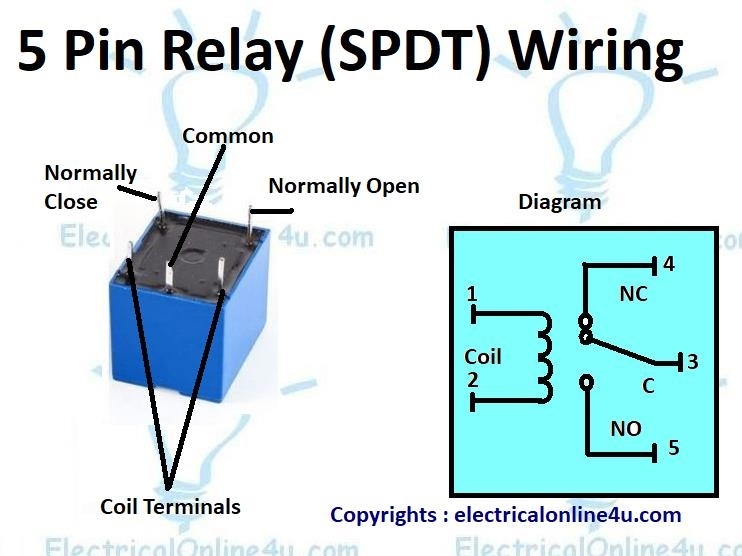Unlocking the Secrets of the 4-Pin Starter Relay

Ever wondered about the magic behind turning your car key and hearing the engine roar to life? A small but mighty component, the 4-pin starter relay, plays a pivotal role in this process. This seemingly simple device acts as an electrical switch, controlling the high current flow to the starter motor. Without it, starting your car would be a much more complicated affair.
The 4-pin starter relay's function is to bridge the gap between the ignition switch and the starter motor. The ignition switch, activated by your key, doesn't directly power the starter. Instead, it sends a small current to activate the relay, which in turn closes a high-current circuit, allowing power to flow from the battery to the starter motor.
Understanding the operation of a 4-pin starter relay is essential for any car owner. It empowers you to diagnose starting issues, potentially saving you time and money. This article will delve into the inner workings of this crucial component, exploring its purpose, operation, and common troubleshooting techniques.
Imagine trying to start your car directly from the battery every time. It would involve heavy-gauge cables and a complicated switching mechanism. The 4-pin starter relay simplifies this process significantly. It acts as an intermediary, allowing a small current from the ignition switch to control a much larger current flowing to the starter motor.
From a historical perspective, starter relays emerged as a solution to the limitations of directly switching high currents. Early vehicles often used cumbersome manual starting methods. The development of electric starters and relays significantly simplified the starting process, paving the way for the modern automotive starting systems we rely on today.
The 4-pin starter relay typically has four terminals: 30 (battery positive), 85 (relay coil positive), 86 (relay coil ground), and 87 (starter motor). When the ignition switch is turned to the start position, it sends a small current through terminals 85 and 86, energizing the relay coil. This creates a magnetic field that closes the contact points inside the relay, connecting terminals 30 and 87. This allows the high current from the battery (terminal 30) to flow to the starter motor (terminal 87), cranking the engine.
One of the main benefits of using a 4 pin starter relay is safety. By using a low-current circuit to control a high-current circuit, it reduces the risk of electrical fires and damage to the ignition switch.
Another benefit is reliability. The relay ensures a consistent and strong connection to the starter motor, improving starting performance. This eliminates the need for excessively thick wiring from the ignition switch to the starter.
Finally, it simplifies wiring and makes the starting system more compact and efficient.
Troubleshooting a 4-pin starter relay involves checking the connections, testing the relay with a multimeter, and inspecting the starter motor. If the relay is faulty, replacing it is a straightforward process.
Advantages and Disadvantages of a 4-Pin Starter Relay
| Advantages | Disadvantages |
|---|---|
| Increased safety | Potential relay failure |
| Improved reliability | Requires some understanding for troubleshooting |
| Simplified wiring |
Best Practices:
1. Use the correct type of relay for your vehicle.
2. Ensure all connections are clean and tight.
3. Regularly inspect the relay for signs of damage.
4. Use a wiring diagram to ensure proper installation.
5. Consider carrying a spare relay for emergencies.
FAQs:
1. What happens if the relay fails? The engine won't crank.
2. How do I test a relay? Use a multimeter.
3. Can I bypass a relay? It is not recommended.
4. What causes a relay to fail? Several factors like high current draw, overheating, or internal component failure.
5. How long do relays typically last? They can last for several years depending on usage.
6. Where is the starter relay usually located? Often near the battery or fuse box.
7. What are the symptoms of a bad starter relay? Clicking sound, no crank, or intermittent starting problems.
8. Can a bad starter relay drain the battery? No, a faulty relay itself won't drain the battery, but a shorted relay might.
Tips and Tricks: Regularly check your relay’s connections and condition, especially in harsh environments.
The 4-pin starter relay, despite its small size, plays a critical role in the functioning of your vehicle's starting system. Understanding its workings allows for better troubleshooting and maintenance, leading to a more reliable and safer driving experience. Its benefits include enhanced safety by isolating the high current circuit from the ignition switch, improved reliability due to its robust design, and simplified wiring which makes installation and troubleshooting easier. By understanding its operation, recognizing potential issues, and following best practices, you can ensure your vehicle starts reliably every time. Familiarizing yourself with the function of a 4-pin starter relay empowers you to address potential problems efficiently and effectively, contributing to a smoother and more confident driving experience. This knowledge can save you time, money, and the frustration of being stranded with a car that won't start. Investing time in learning about this crucial component is a valuable step toward becoming a more informed and proactive car owner.
Sudan sand paint color unearthing the deserts hues
Decoding school behavior agreements a parents guide
Skyline gray sherwin williams the ultimate guide













